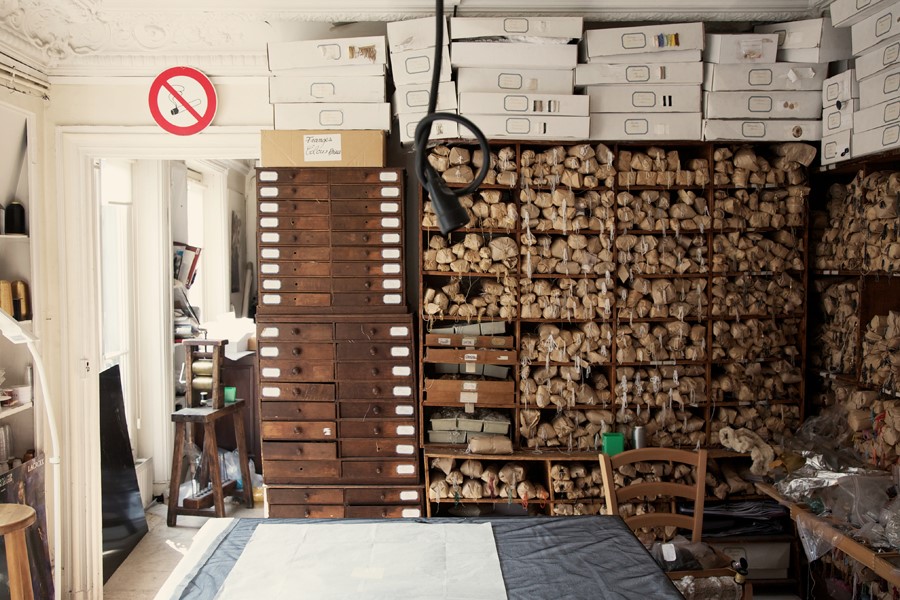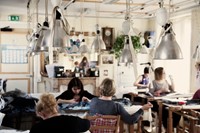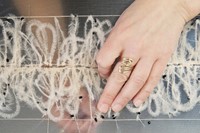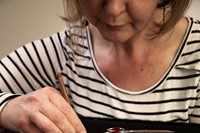As part of our series on Chanel’s famous ateliers, Insiders travels to fabled embroiderers Lesage
“Haute couture without embroidery is non-existent," insists Karl Lagerfeld and the man he has been turning to for over 20 years now is Francois Lesage and his fabled atelier de broderie, Maison Lesage. In this immaculately preserved five-story building overlooking the Sacre Coeur, sunlight streams through the attic windows, illuminating the artisans hunched over swathes of tulle, chiffon and organza stretched across wooden frames, meticulously stitching cabochons, rhinestones, glass beads, paillettes, sequins and pearls. You get a sense of the exquisite lightness and matchless skills of these artisans as the gentle murmurs of the artisans is punctuated by needles dancing deftly across fabric, memorably described in Loic Prigent’s documentary Signe Chanel as “the sound of mice running across the room.” A royal blue feathered and embroidered dress from Galliano’s last couture show for Dior hangs in the corner, as a seamstress tells me how demand for the dress has shot up ever since news of Galliano’s ignominious exit. We see several petites mains working on pieces from Chanel’s recent Metiers D’Arts collection (a sombre ode to the Byzantine era) and by some good fortune, are treated to a sneak preview of Lagerfeld’s upcoming Cruise collection for Chanel. Browsing the opulent Lesage archive – containing over 40,000 samples dating back to 1860 – is like being given a lesson in fashion history.
We are in luck today because we are granted an audience with Monsieur Lesage himself. At 82-years-old, he is the only remaining original artisan of the seven ateliers that make up Chanel’s PARAFFECTION. As a young man he was introduced to fabled couturiers as Worth, Vionnet and Schiaparelli when his father bought over Michonet (once embroiderers to Napoleon) in 1924 and renamed the firm after himself. Lagerfeld once said of him – “He has exceptional intelligence, culture, creativity and speed. Lesage truly is different because there’s an incredible style, technique and savoir-faire.” Lesage is in fine form today – regaling me with tales of Hollywood where he ran a business that served costume designers like Adrian and Jean-Louis and his encounters with the likes of Lana Turner and Ava Gardner. He recounts tales from couture’s ‘golden era’ – of having to enter Cristobal Balenciaga’s studio in monastic silence or how Chanel wouldn’t work with him because she was a sworn enemy of his patron, Elsa Schiaparelli. “In that time you had haute couture or nothing,” he reminisces. “There were only two collections in those days. But petit-a–petit, I see couture and ready-to-wear come together.” Far from being stuck on tradition, Lesage has moved with the times, adopting new techniques and in 1992, opened up an embroidery school, in a concerted bid to conserve the legacy of Lesage.
The petites mains are obviously devoted to him, some having been with this atelier for many decades. Director of Lesage, Murielle Grzesczyk is a case in point – having met Lesage at the age of 18, she came for one month during a summer holiday and is still here 20 years later. “It was by chance – it was not planned,” she laughs, “I came for one month and I never left! Monsieur Lesage says either you stay for one day or forever.” To see such a rare, exalted craft in rude health is heartening indeed, proof that a glorious anachronism such as haute couture can exist and indeed be relevant in these troubled, times. Or as Monsieur Lesage reminds us – “This house was made in the age of couture. If we were not here, couture will fly away.”
AnOther's final Chanel Metiers D'Arts instalment will be posted next Wednesday.
Special thanks to Marilyn Smith



